Ralph Paine – 25 March, 2015
The ten rooms combine to generate a somewhat meandering yet nevertheless circular journey - circles within circles, the karmic chronology of birth, death, re-birth … Stages on (a) life's way, points and parts, platforms, classes, zones of transference, the endless (de)construction of altars. Here it's all ritual and alchemy, exchange and sacrifice, gifts and theft, debt and guilt - in other words, business as usual, (a) quotidian subsistence on display; survival and investment strategies abound.
Auckland
Billy Apple®
The artist has to live like everybody else
Curated by Christina Barton
14 March - 21 June 2015
Artspace
Billy Apple®
Suck (Part I of Poetry in Motion)
Curated by Misal Adnan Yildiz
6 March - 20 March 2015
Here the world has become concept - from now on, its being consists in making space for the space, imaging the image, and measuring the measure. The image of the orb assists this process of becoming understood being. An image, this image, an orb, this orb …
- Peter Sloterdijk, Globes: Spheres II
Orb? An apple is an orb, fruit of the tree of knowledge, the One. But the One always divides into two, and two into three, four, and so on, ad infinitum.
The phase space is trans-active, dynamic. It is composed - and continually recomposed - by vectors, modulations, and tensions travelling between two virtual poles of attraction. One pole is named (post)industrial production, and the other, art. The (post)industrial production pole is marked by the term ‘work’ and is occupied by the persona of the artisan-technician.† This persona is centred, totalising, fully integrated, and regulated. (Post)industrial production has a distinct utility: it is the pole of the ‘we’, of social entrepreneurs and collectivism, functionality and fabrication. The art pole, on the other hand, is marked by the term ‘free action’ and is occupied by the persona of the artist. The artist is sovereign, an autonomous and singular expressiveness. Intuitive, broken up, de-centred and traversed by the invisible, the artist occupies the potential site of play, poetics, and fabulation. The phase space - this conceptual nexus or field of art and non-art, poiesis and techne, play and work - is already there, given, readymade. But there is something else, something remarkable, and this is the shifting, always renewable relation to the space of subjects. Subjects are openings onto the space, points of view, transcendental (w)holes. Of it and yet not of it, both excess and void, subjects condition the phase space.
At Auckland Art Gallery Toi o Tāmaki, Billy Apple®: The artist has to live like everybody else. The building which hosts the exhibition subsists in the phase space. The material flows of the building - the concrete, steel, wood, wiring, fabrics, and so forth - are all moving at various rates of extreme slowness compared to the speed of the flow of light in the galleries, offices, and corridors or the speed of electricity powering the air-conditioning, lifts, and computers. Perhaps somebody here is experiencing an extreme rush of thought, while in comparison her metabolism is slowly digesting lunch. But we note that the building also hosts an organisation, that is to say, a to-some-degree formalised model for action, praxis. The slowly - or at times more rapidly - mutating rules, codes, norms, schedules, and other abstract procedures of the organization affect the faster, more spontaneous movements of the subjects who come and go here; training them, channelling and controlling them, and thus creating habits. The phase space comprises many related yet diverse organisations, from very small groups, enterprises, associations, to large collectivities and institutions, all connecting, disconnecting, and reconnecting to create mutating allotments and regions of the space. Organisations condition the phase space.
The artist presents ideas. Ideas are presentations, presence, eidos. The artist presents presentation as such, the idea of the idea. Ideas are not regulative wholes or unities of thought. Nor are they necessarily precise or clear. Rather, ideas are always both incomplete and multivalent; they not only possess many applications, interpretations, values, but they hold also the potential to take on new ones. Ideas work using fuzzy, on-the-way type logic, that is to say, a logic employing methods of semiotic sketching and feedback - this sometimes via a purely linguistic register, or at other times employing a far more mixed semiotic. But whatever the case, ideas induce open and dynamic processes: they move, and we move with them; we move, and they move along with us. Ideas, then, are embodied thought, diagrammatic expression - they’re entangled within the given phase space. They don’t occupy a separate zone. Every idea has its own body, or series of interconnected bodies, its own materiality. And every body, every materiality, is a potential for further thought, a becoming thought.
How could it be that the artist has to live like everybody else? Is it not the case that the artist has to live like an artist lives, and thus precisely not like everybody else - not, that is, like all those who comprise this ‘everybody else’ and however it is that they might live? In order for the artist to be an artist in the first place, must she not separate herself from this ‘everybody else’ in regards to whom she thinks she is and how it is that she might live? There is the artist, and there is everybody else: a dyad of identity/difference, two sides, duality. Or: might it be the case that the artist has to live like everybody else by merging with this ‘everybody else’; that the artist has to transform her identity/difference as artist and become like the others, that is to say, become the same? This would be the becoming-everybody of the artist, a becoming-generic or being-whatever. Not, that is, the more familiar ‘everybody becoming an artist’ - although this seems viable too - but rather that the artist escape, disappear, exit sans ‘art’ attribute into the commonality of this ‘everybody else’: commonism. Or further: could it be that the artist has to live and everybody else has to live too? In other words, is the statement ‘The artist has to live like everybody else’ a plea on behalf of human life as such; a plea, then, for the continued granting of life to what Marx called our ‘species-being’? In which case, to whom or what might this plea be addressed? God? Gaia?
On Level One, the first space comprises nine named rooms: Young Contemporary, The Electric Gallery, In the Area of Negative Condition, Art Transactions, From the Collection, The Ultimate Standard, A Brand Looking For a Product, Good Works, and The Immortalisation of Billy Apple® - and one unnamed room. These ten rooms combine to generate a somewhat meandering yet nevertheless circular journey - circles within circles, the karmic chronology of birth, death, re-birth … Stages on (a) life’s way, points and parts, platforms, classes, zones of transference, the endless (de)construction of altars. Here it’s all ritual and alchemy, exchange and sacrifice, gifts and theft, debt and guilt - in other words, business as usual, (a) quotidian subsistence on display; survival and investment strategies abound. So there’s every activity imaginable: cleaning, bleaching, elimination, selling, pre-selling, bartering, paying, sampling, withholding, deleting, archiving, packing, unpacking, negotiating, monitoring, figuring-forth, out sourcing, better-by-designing, marketing, experimenting, commissioning, proposing, copyrighting, copy writing, plus more. And an exhaustive/exhausting inventory of the by now generic technical procedures of the contemporary game: photography, typography, film, serigraphy, lithography, neon, painting, sculpture, drawing, modelling, video, etc. etc. Blend it, mix it up, and then render the entire phase space visible. Become the phase space, make it work, be somebody, protect yr data - and fuck this accursed entropy slope! But throughout the ten rooms, always the silent presence of a Self (ātman) who contemplates the I (aham) who is actioning all the action.
Alongside the first space, yet divided from it, a second space - one long corridor named The Given as an Art-Political Statement. Tranquil as a morning rāga, here the register shifts. To become: a line not a circle, air not gold ‘n’ shit, Aion not Chronos, deterritorialisation.‡ There’s a melodic ‘site/nonsite’ vibe humming sweetly along this line. A cartography of actual elsewheres unfurls. It’s like being up the Hudson River inside some cosmically beautiful gallery at Dia Beacon. Minimalism and small b/w photography, exquisite typography and framing, little diagrams on gridded paper, plans as plastic cut-outs, delicate collage, Rymanesque elements attached inside frames or leaning on the white wall. Plain ideas and simple instructions … All is as if crafted and installed by Shakers. Thus, if in the first space we experience an all encompassing movement, a circular measure and unification of each Present of the artist’s life, in the second space - open ended and seemingly limitless in both directions - the artist and the life magically vanish, disappearing into ‘the Instant which is endlessly displaced on this line and is always missing from its own place’.°
Of the scattered parts of Osiris’s body the only one which Isis did not find was the male member … but Isis made a replica (mimena) of the member to take its place, and consecrated the phallus, in honour of which the Egyptians even at the present day celebrate a festival.
- Plutarch, Moralia
The phase space is a vampire.* Everybody is sucking or letting themselves be sucked. Everybody wants to live forever or is contemplating suicide. At Artspace, Billy Apple®: Suck. Here we encounter surplus: Suck is the artist’s extra-part. Centred on each of the four walls of the squared main room, four small canvases, each delicately developed in grey tone with what seem to be images sampled from ‘60s gay porn magazines. At the centre of the room, a tubular rendition of the word ‘Suck’ - cast like candy in high car paint shine - stands upright in its Plexiglas display case.
Suck=$uck=®ED=Pantone185=Blood=C-M-C’=Art=BiosTM … A general equivalence.
Today the Phallus no longer mediates, it circulates. Endlessly, 24/7. Through a doorway bathed in the sumptuous red glow of a beautifully painted and no doubt finely proportioned section of wall, we enter a long and dimly lit room. Centred on the far end wall is another small canvas. Gazing down the length of the room, the image on the canvas appears in the soft distance as a vertically erect penis. But walking closer and closer in, quite unexpectedly it appears now to be a (wo)man’s arse. It’s like the famous image of an urn that suddenly transforms to become two faces in profile, and vice versa. The soft ‘n’ fuzzy darkness between the cheeks of a (wo)man’s arse, or an erect penis? We can switch the whole thing around, either/or, it swings both ways. Of it and yet not of it, both excess and void, the gaze conditions the phase space.
Meanwhile, out on the street, the fleeting glance of a young Chinese woman wearing Calvin Klein jeans and a black t-shirt proclaiming - in chunky white text contoured divinely across the front - IN GOLD I TRU$T.
Ralph Paine
† Might we consider curators, managers, cleaners, baristas, accountants, lawyers, security guards, architects, etc. all to be artisan-technicians? In this sense, lawyers would be artisan-technicians of the law, curators artisan-technicians of the archive, cleaners artisan-technicians of immunology, accountants artisan-technicians of the double-entry, etc.
‡ Aion and Chronos are Deleuze’s two different ‘readings of time’. See Gilles Deleuze, The Logic of Sense, trans. Mark Lester, with Charles Stivale, ed. Constantin V. Boundas (New York: Colombia University Press, 1990).
° Deleuze, LoS. 166.
* With apologies to Billy Corgan.
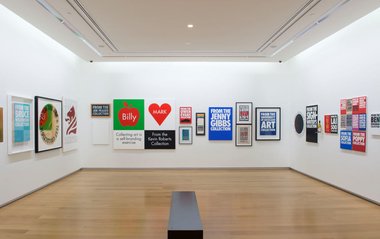
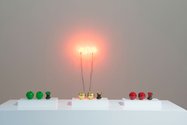
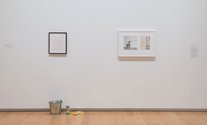
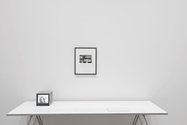
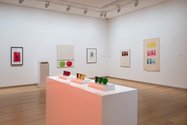
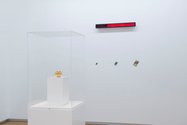
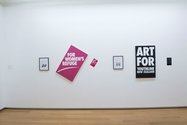
 Two Rooms presents a program of residencies and projects
Two Rooms presents a program of residencies and projects Advertising in this column
Advertising in this column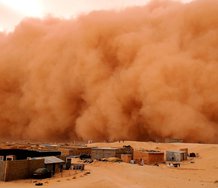
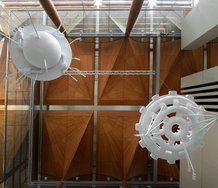
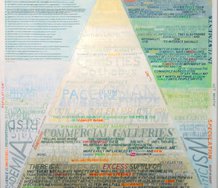
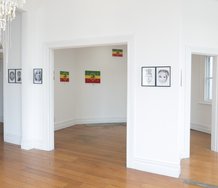
This Discussion has 0 comments.
Comment
Participate
Register to Participate.
Sign in
Sign in to an existing account.